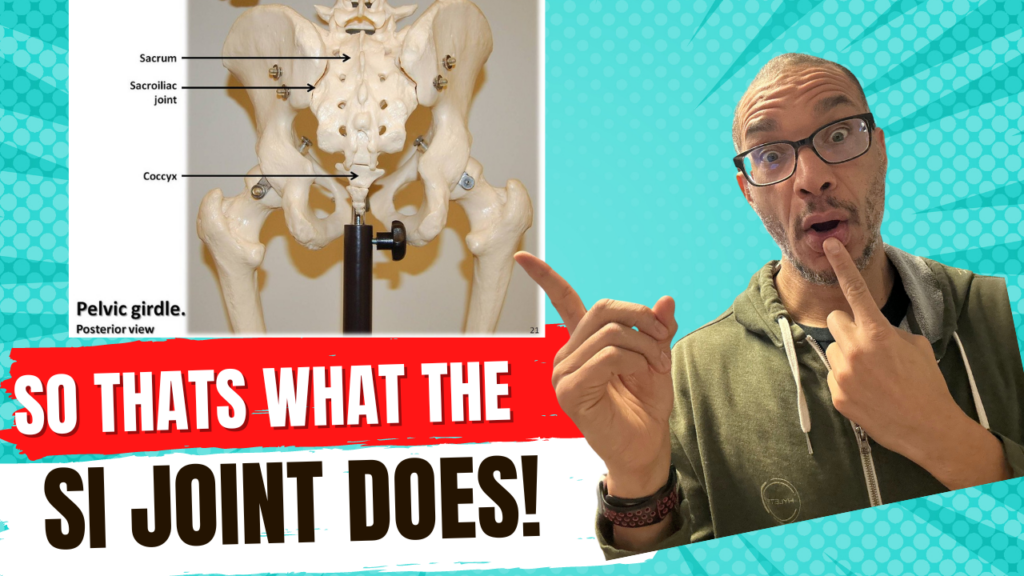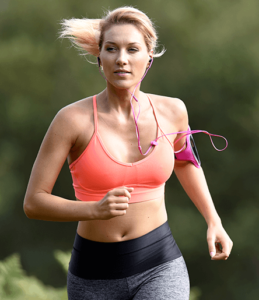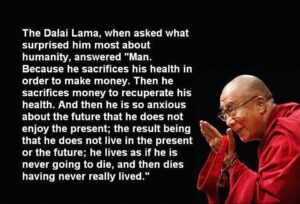The sacroiliac joint, or SI joint, is a complex joint that can lead to holding you back from your goals. And it’s even harder when you look for answers, and the information you get is from sources that don’t have the full picture. Thi sis a problem because a dysfunctional SI joint will inhibit gaining strength and mobility and will cause pain and injury. So, if you’re looking for SI joint exercises, SI joint pain relief, strength, or mobility, check out this video first so you can get the deets on how to work with your SI joint.

The SI joint is not completely understood by a lot of people. You may say it’s problematic because when you want to go to work with it, you can’t work with it properly. If you can’t work with it properly, that leaves the door open to a lot of unbalancement, dysfunction, pain, immobility, all these fun things that nobody wants. So I want you to stay tuned because in this week’s video, I’m going to do a deep dive into the SI joint, but it’s going to be understandable, not too scientific. Greetings, I’m Ekemba Sooh, I own SolCore Fitness. It’s a therapy and fitness company where we work in-house here in Santa Fe, but also through our online program. I’ve been in this field for 30 years and I started as a regular trainer, but about halfway through I realized that I need to find a different way because when I got hurt, the traditional way of doing things, PT, chiro, corrective exercises didn’t produce the results that I knew I could get.
So luckily I found osteopathy and its holistic view of the body. It made total sense to me and so I dived in, I got a lot of results. So that’s what I talk about here in this channel is a holistic view on the body. Not, “I’ll give you three exercises to correct this issue,” Which doesn’t really work. So if you like this, please subscribe. If you like the video, give it a thumbs up and share with your friends. Each week I’ll put out a video so when you subscribe and hit that bell, you’ll be notified to get the new release. So when people come into my studio or I interact with them online, one of the first things I talk about or check is the SI joint. That’s because the SI joint is part of the pelvis. The pelvis, you can say, is the floor of the body or connects the upper half and lower half of your body. So that SI joint is a combination of your ilium, your hip bone, and your sacrum and the space in between. That’s your SI joint.
You have two SI joints because you have two hip bones. So if the SI joint is off, the pelvis is off, which means your whole body is off. That’s why when they come into the studio, it’s a joke with the people who do what I do, we say take off your pants. Now you don’t totally take off your pants, I don’t want to get in trouble here, we’re putting our fingers on the skin in this area right here at the SI joint in different parts and we have to do a bunch of stepping tests. We want to see how that moves. This is going to allow us to understand more about what’s going on with them because that SI joint is usually asymptomatic. They don’t know that they have an SI joint problem. They’re coming in for a shoulder issue or a knee issue or something of the sort and we go, well, let me check this first because if I go directly to the shoulder or the knee, in this example, and I don’t check the floor of the body, I can correct those all I want, the floor is off, the body’s off.
The SI joint is a total joint. By total joint I mean that it has a capsule around it. It has synovial liquid. Synovial liquid helps bring nutrition into that area and do a bunch of good things. It has little Proprioceptors, little computers within it, to communicate to the rest of the body about what’s going on within that joint. There’s ligaments in front and behind that, your sacroiliac ligaments in front or behind, that also have computers in them, that also help to communicate to the rest of your body to help manage that joint. There’s muscles involved in that joint that help stabilize and move that joint, either directly or indirectly, namely the piriformis, the glute max deep, the glute mead, the glute max superficial, and then the obturatorius and iliopsoas for the fascial connections. The SI joint has a lot of different areas within it that are important to know because if you want to be specific with how you want to work with it, you need to know these areas.
So in this SI joint, you have different lesser arm and greater arm and apex and base. The SI joint looks like a boomerang, okay? So in that boomerang, there’s a top part of my body, there’s a bottom part of my body. The top part is your lesser arm, the bottom part is your greater arm. So you have two of these and then within these arms, you have an apex, a base, a base, and an apex, and then right in middle, you have an ismus, means middle. So you have that on both sides. You also have a bunch of different movements the SI joint can make. The only physiological movement it can make is called an oblique axis. Oblique axis means here’s my hip bone, here’s my sacrum. If the sacrum moves forward, the hip goes forward and a little back, it goes back, it does the opposite. It does that on both sides. That’s what happens when you walk around and move, okay? So that happens normally if you don’t have any issues.
If you have issues, you have 20 more pathological axis that can happen, and then you have a bunch of combination of these pathological axis and more stuff to equal… A lot of stuff that can go wrong with your SI joint. So again, it’s important to know all that because you’re not testing all of them at once, but you want to understand that there could be many different reasons why you have an SI joint problem, not one or two. So you can’t tell me it’s not a complete joint. I say that because there’s a lot of practitioners out there who think that it’s not a total joint, that it’s fused or that the actions it has are more basic and not as intricate as they’re going to go into here in a little bit. It’s just problematic because if you go to one of these people and they don’t know all this information, then they’re either going to give you something simplistic expecting a result for a complex situation or just ignore it all together because they say it’s not there and your body doesn’t use it at all.
As I said before, the SI joint, an SI joint issue, could be asymptomatic, but it could still be a symptom of what’s going on. I’ll use me for example, and I’ve said this before but I’ll repeat it here. So I got L four or five compression, disc bulge and sciatic pain. I had no idea I had an SI joint issue, which was in combination with other things, because of that problem. But because my SI was off, my spine couldn’t sit in a good place and couldn’t operate from a good place, which then caused me to have, again with other things, to cause to have that issue. But I didn’t know what an SI joint was back then. I didn’t really know what it was and how it moved. And then all the practitioners I worked with afterwards, chiros, doctors, acupuncturists, PTs, they had little or no knowledge of the SI joint, which means they couldn’t really help me to get better. An SI joint issue could lead to a false short or long leg, it could lead to pelvic imbalancements, it could lead to tight muscles in the front or back of your hip and leg, it could lead to pelvic visceral problems.
Your issues don’t have to be orthopedic, it could be visceral. It can lead to hip pain on the inside or outside, it could also lead to pain away from the pelvic area. It could be knee pain, it could be upper thoracic or shoulder pain. Again, if the floor of your body is off, just think about the floor in your house, wherever, if that floor is off and dysfunctional, then everything associated with that floor, in this case above and below, it’s also out of balance and dysfunctional. Are you working through SI joint issues or after hearing me now, do you think you also need to incorporate some SI joint work into what you’re doing? Well, let me know what you’re doing. Put it in the description below. And then stay tuned, we’re going to talk about how I would work through the SI joint issues. For the first step in figuring out your SI joint issues is to have an assessment. I know that sounds basic, but you need to assess where in the SI you have issues. You can’t just say SI joint issues and then do some basic protocol.
People think, “Oh, I’ve got SI joint issues.” They type it into YouTube and all of sudden they get a bunch of videos saying, “Hey, do these three moves or this one move to get rid of your SI joint issues.” One, at best, it’s not specific enough, it won’t give you lasting results. At worse, it can make matters worse. So within the SI joint, like I talked about, there’s different areas. Again, you have a lesser arm and greater arm. Is your issue coming from the apex of the lesser arm, the base of the lesser arm, the ismus, the base of the greater arm, the apex of the greater arm or, more than likely, is there a combination of these and the other pathologies, the 20 pathologies that I talked about? First find that out or start where you think mainly it’s coming from because you’ll never be a hundred percent correct at the beginning, but you’ll get an idea of which way to go down. And then you train and treat that area specifically.
So whenever you have a dysfunction in your body, something goes out of place, then the area around it, namely your soft tissue, becomes dysfunctional. So I have an issue with my SI joint and then the ligaments around that area become confused. They start to have different information or bad information or no information because they get shut off, they become dry or too tight or too loose and then the muscles associated with that area also become too short or too weak or too less mobile because the muscles are told to do, by the fascia, because the ligaments are also the part of fascia, so they go with the fascia tells them. So you have to start working with those different areas. For me, I would start working with the ligaments first because the ligaments are the intelligent part of the body. They tell the body what’s going on. So I work with techniques that I would use like double TLS, which means I’m going to turn a ligament on, I’m going to wake it back up.
I’m going to use pumping to increase that flow of fascial liquid through those collagen tubes again because when I hurt myself, I stopped the flow of liquid, which means I stopped the flow of information, healing and waste removal. They’re going to work with the different fascial connections with fascial normalization because, again, it’s not just the area working, it’s the fascial chain that’s also being compromised, so I do fascial normalization and I take that exact same concept into the exercises I use. So again, with those exercises I said before, piriformis, the glute max, deep and superficial, the obturatorius, the iliopsoas, what am I forgetting? Did I say piriformis? I forgot what I said. But all those muscles I said I’m going to work not with just the muscle, but with the myofascial chain that’s involved because the body’s built holistically. Everything has a place, everything has a job, they all work together. So it’s not just about the issue I have with my SI joint or the surrounding areas, it’s about the chain that’s involved.
So I’m going to work within that chain, therapy wise, but then also exercise wise while I strengthen and while I stretch altogether. Everything combined, holistic. If you want to find out more on how to work with your body holistically because you now understand that that’s the most advantageous to work with it, because that’s how it’s built, then I’d love to help you. You can join my private Facebook group. So in the description below, there’s a link for it. It’s an interactive way to find out more. So you just click on that link, you answer a few questions, you agree to the terms, voila, you’re in. You can interact with me, you can take part in challenges where we take a topic, say SI joint and I talk about it, but also show you exercises you can do for it, you can participate in masterclasses where I’ll talk more in depth about whatever topic comes up or I just do little mini trains, like a little one, two minute, three little minute videos to let you know more about different topics that have come up in the group.
Or you can get my free ebook if you don’t want to be interactive. So in the description below, again, just click on it, put in your information, get instant access. It’s how to get strong and mobile and live your best life, those four steps. In there, I’ll talk more about what those four steps are and I’ll just start to work with it. And if you want to start now, then interact with me, schedule a consultation with me, use the link in description below to set up a time to talk with me personally where I can talk you through what you’ve been doing, your sticking point where I see you should go and only if I see you’re a good fit will I offer my services to you, either here in-house or with my online program. But I hope this allowed you to see a little bigger view of how you should be working with the body. Please stay tuned for next week. We’ll talk more about some holistic fashion and have a great day.
SI joint is not completely understood by a lot of people. And this may seem problematic because when you want to go to work with it, you can’t work with it properly. If you can’t work with it properly, that leaves the door open to a lot of unbalancement, dysfunction, pain, immobility, all these fun things that nobody wants. So I want you to stay tuned because in this week’s video, I’m going to do a deep dive into the SI joint, but it’s going to be understandable, not too scientific. So you can’t tell me it’s not a complete joint. I say that because there’s a lot of practitioners out there who think that it’s not a total joint, that it’s fused. This is problematic because if you go to one of these people and they don’t know all this information, then they’re either going to give you something simplistic expecting a result for a complex situation or just ignore it altogether because they say it’s not there and your body doesn’t use it at all.

MOVE BETTER, REDUCE PAIN, AND LIVE LIFE ON YOUR TERMS
it’s not just working out, it’s building a foundation for a better life.
Find out more @



Leave a Reply